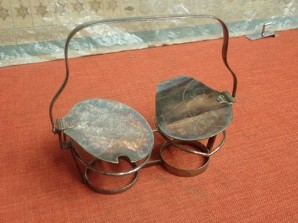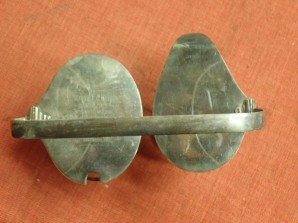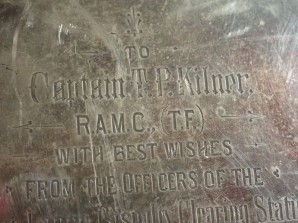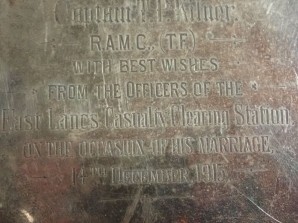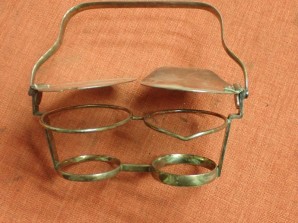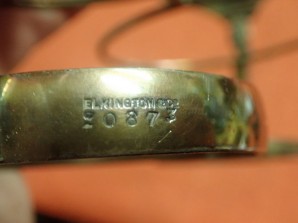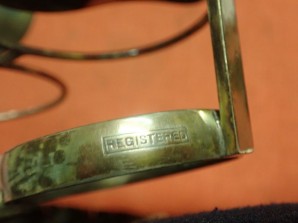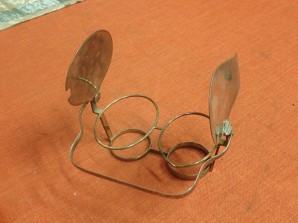EAST LANCS, 1915 PRESENTED CONDIMENT CARRIER
Stock No. 122657
Product Information
Out of Stock
UNIQUE ITEM. ENGRAVED TO ONE OF THE TOP COVERS ” TO CAPTAIN T.P. KILNER, R.A.M.C. (T.F) WITH BEST WISHES FROM THE OFFICERS OF THE EAST LANCS CASUALTY CLEARING STATION, ON THE OCCASSION OF HIS MARRIAGE. 14TH DECEMBER 1915″. WITH THE HANDLE UP, STANDS 7.25 INCHES TALL. 8 INCH ACROSS. FOR HOLDING TWO POTS OF JAM, OR MUSTARD, ETC. WHEN THE CARRYING HANDLE IS DROPPED DOWN, THE TWO COVERS AUTOMATICALLY LIFT TO EXPOSE THE PLACED IN CONTENTS. MAY BE SILVER, OR SILVER PLATE, NO MARKINGS EITHER WAY.
Born on 17 September 1890, the son of a master at Manchester Grammar School, he was educated at Queen Elizabeth Grammar School, Blackburn, and at Manchester University, where he won the Dauntesey Scholarship and the Sidney Renshaw Exhibition and was later awarded medals in anatomy and physiology. He won distinctions in surgery and pathology when he qualified in 1912.
Kilner was demonstrator of anatomy in the University of Manchester from 1912 to 1914 and was senior house-surgeon at Manchester Royal Infirmary. He served as a Captain in the RAMC during the first world war, being surgeon to No 64 Casualty Clearing Station in 1915 and surgical specialist to No 4 General Hospital in 1918. After the war he was appointed plastic surgeon to Queen Mary’s Hospital for Face and Jaw Injuries, Sidcup, and there with (Sir) Harold Gillies he helped to establish plastic surgery in this country. Kilner later became consulting plastic surgeon to a large number of hospitals.
There were only two plastic surgeons in the United Kingdom in 1921, Gillies and Kilner, and their team-work and technical achievement were an inspiration to many surgeons. One week-end in every month they visited John Grocott at Stoke-on-Trent, who was the first provincial surgeon to show a keen clinical interest in the new speciality. In 1931 Kilner joined the staff of St Andrews’ Hospital, Dollis Hill, where a pavilion with two wards and an operating theatre were devoted to plastic surgery alone, and worked there up to the second world war. Kilner in London and W E M Wardill in Newcastle worked in collaboration, became close friends, and perfected the operation for palate repair originally designed by Victor Veau of Paris. From his study of congenital deformities Kilner became interested in speech therapy, and was elected a Governor of the Central School of Speech Therapy and of Moor House Residential School.
Teaching hospitals showed little interest in plastic surgery until St Thomas’s appointed Kilner as associate Plastic Surgeon in 1934; he became a Governor of the Hospital when the National Health Service began in 1948. Kilner was a Hunterian Professor at the College in 1935, lecturing on the transplantation of skin. In 1939 only three London teaching hospitals had appointed consultant surgeons in plastic surgery, and the provinces were visited from London; Kilner visited the Manchester Royal Infirmary every month, while he and Rainsford Mowlem both visited Birmingham; when he died there was hardly a teaching hospital in the British Isles without a plastic surgeon on the permanent staff. Another achievement was the creation of the plastic surgery unit at Stoke Mandeville Hospital, built in 1941; in the same year he became officer in charge of the plastic surgery division of the Ministry of Pensions. During the second world war Kilner was consultant to the pensioners at Roehampton; he also developed the Bunyan-Stannard envelope for the treatment of burns.
Kilner was appointed the first Nuffield Professor of Plastic Surgery at Oxford in 1944 and occupied this Chair until 1957 when he retired with the title of Emeritus. He was a Fellow of St John’s College. Kilner was President of the British Association of Plastic Surgery in 1948 and 1955, and was an honorary member of many medical societies at home and abroad; after retirement he was appointed to the General Medical Council.
Kilner had an easy and friendly manner with a quick sense of fun, but spoke out when necessary. He was a short strong man of tireless energy; a keen photographer, fisherman, gardener, and bee-keeper. Kilner married twice: in 1915 Olive Mary Brown, by whom he had one son Hugh, but she died while he was an infant, and Hugh who qualified at Cambridge in 1949 died in Egypt on 5 November 1950 aged 26, while serving in the RAF Medical Service (Brit med J 1950, 2, 1283). Kilner married secondly in 1926 Florence Brennan née O’Neil, a widow with one daughter, and they had two sons. He lived at 41 Davenant Road, Oxford and died on 2 July 1964 aged 73, survived by his wife, her daughter and their two sons; Mrs Kilner died on 24 November 1964.

